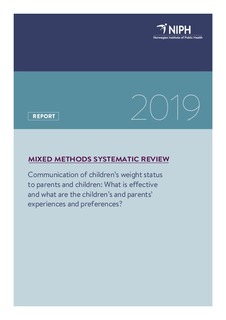| dc.contributor.author | Ames, Heather Melanie R | |
| dc.contributor.author | Mosdøl, Annhild | |
| dc.contributor.author | Langøien, Lars Jørun | |
| dc.contributor.author | Blaasvær, Nora | |
| dc.contributor.author | Nøkleby, Heid | |
| dc.date.accessioned | 2019-12-30T15:04:06Z | |
| dc.date.available | 2019-12-30T15:04:06Z | |
| dc.date.created | 2019-12-30T12:14:37Z | |
| dc.date.issued | 2019 | |
| dc.identifier.isbn | 978-82-8406-038-5 | |
| dc.identifier.uri | http://hdl.handle.net/11250/2634508 | |
| dc.description.abstract | Key message
Early intervention and conversation about a child’s weight may offer a greater chance of success in reducing weight and implementing a healthier lifestyle. This review explores the most effective way to notify parents and children about their weight as well as their preferences for and experiences with weight notification.
Studies of effect found that the format of feedback made little or no difference in parents attending further treatment, recognising their child as overweight or obese, reactions to the way the weight notification is given, motivation for lifestyle change, understanding how to reduce the risk of overweight, or taking any action. However, parents receiving feedback with motivational interviewing have somewhat greater satisfaction with the way the healthcare worker supports them.
Qualitative studies found that parents had clear preferences for the format, timing, content and amount of information they wanted to receive in relation to both the weighing process and weight notification. They also had clear preferences for how they wanted health care providers to interact and communicate with them and their children. Both parents and children often felt that they were not receiving enough information and worried about how their results would be kept private. Many parents experienced an emotional response when told about their child’s weight ranging from positive, disbelief and negative feelings. Those who reacted with disbelief or negatively were less likely to accept their child’s weight status and/or act upon the notification letter.
These qualitative results show that it is important that those working with weight assessment and notification programs take parents’ preferences into account when developing feedback formats, consider the mode of feedback they use and provide parents and children with tailored feedback and personalized follow up once a child is identified as underweight, overweight or obese. | |
| dc.language.iso | eng | |
| dc.publisher | Folkehelseinstituttet, område for helsetjenester | |
| dc.relation.uri | https://www.fhi.no/publ/2019/Kommunikasjon-om-barns-vektstatus-til-foreldre-og-barn-Hva-er-effektivt-og-hva-er-barns-og-foreldres-erfaringer-og-preferanser/ | |
| dc.subject.mesh | Child | |
| dc.subject.mesh | Parents | |
| dc.subject.mesh | Body Weight | |
| dc.subject.mesh | Communication | |
| dc.subject.mesh | Ideal Body Weight | |
| dc.subject.mesh | Body Weight Changes | |
| dc.subject.mesh | Body-Weight Trajectory | |
| dc.subject.mesh | Health Personnel | |
| dc.subject.mesh | Obesity | |
| dc.subject.mesh | Weight Loss | |
| dc.subject.mesh | Overweight | |
| dc.subject.mesh | Thinness | |
| dc.subject.mesh | Motivational Interviewing | |
| dc.subject.mesh | Motivation | |
| dc.subject.mesh | Life Style | |
| dc.subject.mesh | Emotions | |
| dc.title | Communication of children’s weight status to parents and children: What is effective and what are the children’s and parents’ experiences and preferences? A mixed methods systematic review | |
| dc.title.alternative | Kommunikasjon om barns vektstatus til foreldre og barn: Hva er effektivt og hva er barns og foreldres erfaringer og preferanser? En «mixed methods» systematisk oversikt | |
| dc.type | Research report | |
| dc.description.version | publishedVersion | |
| dc.source.pagenumber | 144 | |
| dc.identifier.cristin | 1764351 | |
| cristin.unitcode | 7502,9,1,0 | |
| cristin.unitname | Avdeling for vurdering av tiltak | |
| cristin.ispublished | true | |
| cristin.fulltext | original | |
